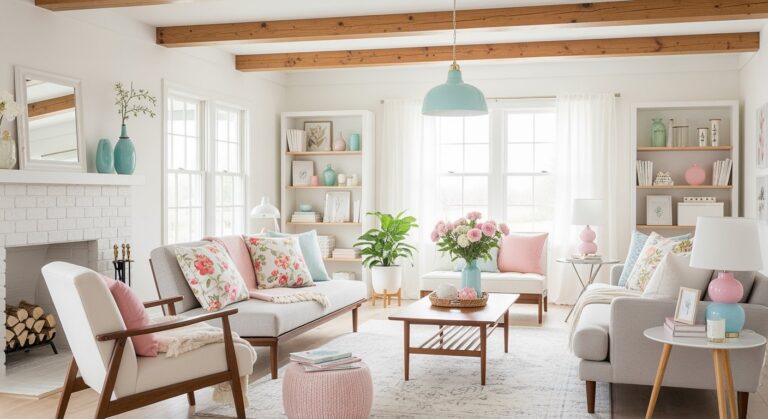Modern and cottagecore.
On paper, it sounds like an impossible mix.
One is all clean lines and minimalism. The other is cozy, nostalgic, and a little bit cluttered.
But sometimes, the most unlikely pairs create something truly special.
It’s a style that’s both serene and soulful.
Start with a Modern Foundation
The secret to making this work is to start with a modern shell.
Think of it as a blank canvas.
Clean lines, simple architectural details, and a lot of open space.
This isn’t the place for intricate crown molding or busy wallpaper.
Start with smooth, uncluttered walls.
A fresh coat of a soft, neutral paint works wonders. Think warm whites, soft grays, or even a moody charcoal.
The floors should be simple and unassuming.
Light wood, polished concrete, or a large, neutral area rug.
This modern foundation provides the structure. It’s the quiet, calm backdrop that allows the cottagecore elements to shine without overwhelming the space.
It’s the order that makes the chaos feel intentional.
It’s clean. It’s modern. It works.
Layer in Cottagecore Textures
Once you have your clean, modern box, it’s time to soften it up.
This is where the cozy, tactile nature of cottagecore comes into play.
Texture is everything.
Bring in chunky knit blankets, worn linen pillows, and maybe a soft sheepskin throw.
These elements instantly add warmth and an invitation to get comfortable.
Rugs made of natural fibers like jute or sisal can ground the space and add a rustic touch.
This is also where you can play with pattern, but carefully.
A floral armchair in an otherwise minimalist room.
Or delicate, botanical-print curtains against a simple white wall.
The key is to use these patterns as accents, not as the main event.
A little goes a long way.
Bridge the Gap with Furniture
Furniture is where these two worlds can really meet.
Look for pieces that blend modern shapes with rustic materials.
A dining table with a sleek, simple top but rustic, weathered wood legs.
Or a modern sofa with clean lines, but upholstered in a soft, textured boucle or a natural linen.
This is also a great place to introduce vintage pieces.
A weathered, antique pine chest used as a coffee table in front of a contemporary sectional.
Or a set of mismatched, vintage dining chairs around a sleek, modern table.
The contrast is what makes it interesting.
The patina of the old pieces adds soul and history. The clean lines of the new pieces keep it from feeling dated or stuffy.
Looks great. Feels right.
Get the Color Palette Right
Color is the glue that holds this whole look together.
Lean heavily on a modern, neutral palette for the big surfaces.
Your walls, your floors, your largest pieces of furniture.
Whites, creams, grays, and blacks.
This creates that sense of calm and order.
Then, sprinkle in the soft, earthy colors of cottagecore.
Think of a wildflower field on a cloudy day.
Muted sage greens, dusty rose pinks, buttery yellows, and faded blues.
These colors can show up in your textiles, your artwork, a painted accent chair, or your collection of ceramic pottery.
They add personality and a connection to nature, which is at the heart of the cottagecore aesthetic.
The neutral backdrop keeps these softer colors from feeling too sweet or overwhelming.
Curate Your Collections
Modernism loves empty surfaces. Cottagecore loves to fill them.
So how do you find a happy medium?
The answer is curation.
It’s not about getting rid of all your stuff.
It’s about being intentional with what you display.
Think open shelving in the kitchen holding a collection of mismatched ceramic mugs and handmade pottery.
Functional, but also beautiful.
A gallery wall can be a great way to incorporate cottagecore’s love for art and nostalgia.
Mix vintage botanical prints, small landscape paintings, and maybe even some pressed flowers in simple, modern frames.
The key is to group items together thoughtfully.
It’s the difference between clutter and a collection.
One feels messy. The other tells a story.
This blend of styles isn’t about following a strict set of rules.
It’s about finding a balance that feels right.
A balance between the calm of minimalism and the warmth of nostalgia.
Between clean lines and cozy layers.
It’s about creating a home that is both a peaceful retreat and a place full of personality and life.

